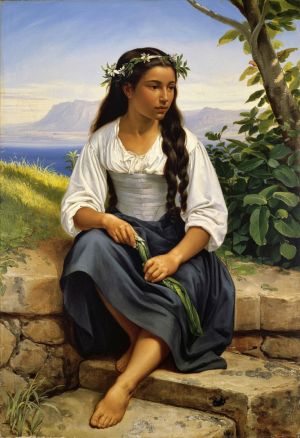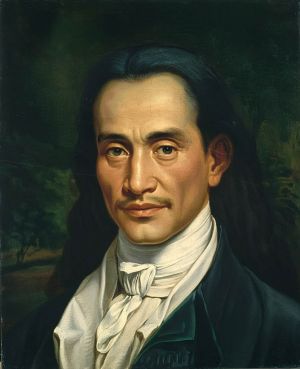Thavariin
| Thavariin | |
|---|---|
| Image |  |
| Plural | Thavariin |
| Spirit Origin | Evrelth |
| Classification | Human |
| Homeland | Sirel Coast |
| Average Height | 5'6"–6'2" |
| Average Lifespan | 50-70 years |
| Distinction | Emotionally expressive culture shaped by coastal intensity and ceremonial catharsis |
| Language | Tharic |
Introduction
The Thavariin are a human-descended people native to the Sirel Coastlands, a rugged and temperamental region of cliffs, mists, and restless tides along the western edge of Orethil. Known for their open emotional expression and highly ceremonial culture, the Thavariin view feeling not as a private experience but as a shared language of memory, transformation, and release. Their society is shaped around cycles of mourning, joy, fury, and quietude—each granted space within public life.
Spiritually, the Thavariin are aligned with Evrelth, the Ascendant Spirit of Emotion. Evrelth represents the entire range of human feeling, both ecstatic and despairing, and is believed to manifest in the sea’s shifting mood, the silence of low mist, or the cry of gulls across wind-cut cliffs. Through this influence, the Thavariin have developed a worldview in which emotional truth carries more weight than tradition or permanence.
Unlike more reserved cultures, the Thavariin make little effort to conceal their inner states. Anger, grief, love, and awe are openly expressed in both daily life and structured rites. While their customs may appear volatile to outsiders, their internal systems of emotional ritual, symbolic attire, and communal balance offer a stable and enduring framework for collective identity.
Origin and Nature
The Thavariin emerged from early human migratory waves during the latter phases of the Great Migration. Unlike other lineages that settled inland or in sheltered basins, the Thavariin’s ancestors established themselves along the wind-battered cliffs and shifting coves of what would become the Sirel Coastlands. Over generations, their culture took shape in direct response to the region’s volatile climate, unstable terrain, and sensory immediacy.
Without the protective enclosure of mountains or deep forests, early Thavariin communities were exposed to sudden storms, intense light shifts, and the persistent roar of the sea. These environmental pressures, combined with limited arable land, fostered a society attuned to internal resilience rather than material continuity. Emotional expression became a communal necessity—a means of cohesion, clarity, and shared endurance.
The Thavariin’s spiritual alignment with Evrelth, the Ascendant Spirit of Emotion, emerged gradually. Oral traditions suggest that Evrelth did not come to them as doctrine, but as a presence—felt in the turning tide, the gut-pull of sorrow, or the euphoric hush before a storm. Over time, rites developed to externalize feeling as a sacred act, with seasonal observances structured around cycles of mourning, celebration, fury, and renewal.
Biology and Physical Traits

The Thavariin are physically comparable to other human lineages, though certain traits reflect generations of adaptation to the variable and coastal environment of the Sirel Coastlands. They typically range in height from 5'6" to 6'2", with sturdy builds and agile movement suited for rocky terrain and unpredictable weather. Skin tones vary from wind-burnished bronze to ash-toned olive, with visible freckling common along exposed areas. Hair tends to be red thick and dark, often worn loosely or tied back for ritual occasions.
Their facial features are expressive and mobile, shaped as much by cultural emphasis on emotional openness as by genetics. Eyebrows, eyes, and mouths tend to show greater motion than in more restrained populations, and social training reinforces this expressivity. Eye colors span from stormy grey and muted green to pale amber, with irises often appearing flecked or ringed in low light.
The Thavariin display a notably high emotional responsiveness, with measurable physiological markers such as accelerated pulse under strong feeling, rapid facial change, and a tendency toward vocalization during emotional peaks. While not biologically distinct in this regard, these traits are amplified by cultural conditioning.
Average lifespan for the Thavariin ranges from 50 to 70 years. Though they have access to similar levels of care and sustenance as other human groups, their lives tend to burn with greater intensity. Emotionally taxing ceremonies, physical expression of grief or joy, and the general openness of their society contribute to both physical strain and a cultural framing of life as a vivid, finite cycle.
Culture and Society
Thavariin society is structured around the open recognition and expression of emotion. Feelings are not regarded as private or disruptive, but as vital elements of personal identity and social cohesion. Public life is organized to allow for visible mourning, joy, anger, and reflection, with communal rituals designed to absorb and respond to these emotional states rather than suppress them.
Daily life incorporates emotional cycles into its rhythms. Each lunar phase corresponds to a particular emotional aspect—grief, elation, reflection, or release—with public ceremonies, attire, and social expectations adjusted accordingly. Thavariin dress is often designed to indicate emotional state, using color combinations, fabric texture, or symbolic fastenings to convey inner feeling. Silence is not discouraged but understood in context—whether reflective, restrained, or overwhelmed.
Communal gatherings are common, but structured around emotional purpose rather than political debate or resource distribution. Lamentation halls, chant circles, and shorefront observances are used for expressing personal or shared feeling, and participation is open but never compulsory. Emotional literacy is taught from a young age, emphasizing both personal recognition and respectful response to others.
Social roles are often fluid, responsive to an individual’s prevailing emotional alignment. While certain professions—such as tide-callers, chant historians, or reflection guides—carry long-term responsibilities, many roles shift with seasonal or internal change. Leadership is consensus-based and often temporary, with decision-making tied to communal emotional states rather than fixed hierarchies.
Outsiders often misinterpret Thavariin culture as unstable or overly theatrical. In practice, their society maintains a strong internal balance through emotional honesty and ritual regularity. Disputes are not buried but processed through formal observances, and joy is not restrained but shared communally. The culture places less emphasis on permanence than on presence—valuing the sincerity of a moment over the structure of tradition.